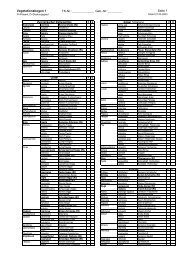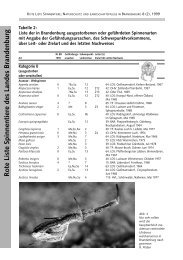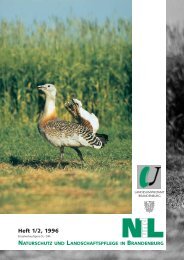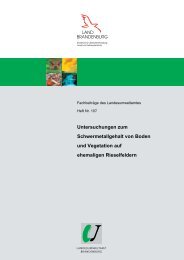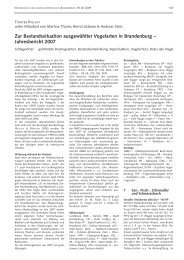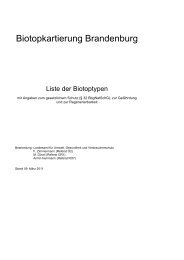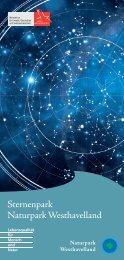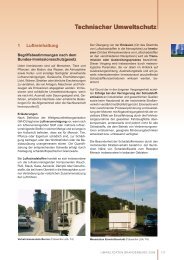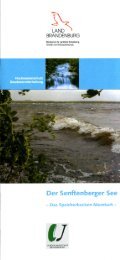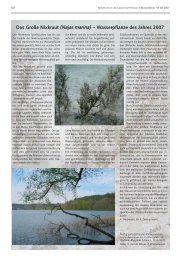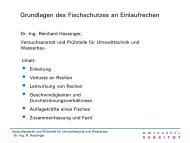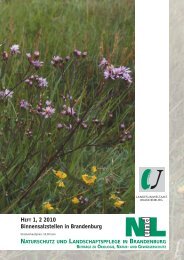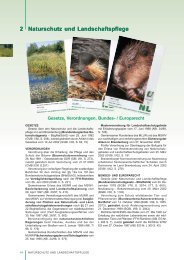Kurzschlüssel Biotopkartierung Brandenburg Waldbogen
Kurzschlüssel Biotopkartierung Brandenburg Waldbogen
Kurzschlüssel Biotopkartierung Brandenburg Waldbogen
Sie wollen auch ein ePaper? Erhöhen Sie die Reichweite Ihrer Titel.
YUMPU macht aus Druck-PDFs automatisch weboptimierte ePaper, die Google liebt.
<strong>Kurzschlüssel</strong> <strong>Biotopkartierung</strong> <strong>Brandenburg</strong> <strong>Waldbogen</strong>EA EigentumsartNaturnähe der Baumartenzusammensetzung1 Landeswald 7 sehr naturnah (≥90 % NWG;EB+FB ≤ 1% )2 Privatwald 6 deutlich naturnah (>50-90 % NWG; EB ≤ 10 %, FB ≤ 5 %)3 Genossenschaftswald 5 ziemlich naturnah (1 BB + 1BB o. PB o. 1 NB aber ≠ alle ( bei mehreren) NB ≥80 % NWG; FB ≤ 5 % )4 Kommunalwald5 Kirchenwald 4 mäßig naturnah (1 BB oder PB ≥ 80 %, EB+FB ≤ 20 %)6 Wald anderer öffentlicher Körperschaften 3 gering naturnah (HB > 50%; EB+FB > 20-50%)7 Treuhandwald 2 Naturfern (HB 20-50 %; EB+FB > 50-80%)8 Bundeswald 1 sehr naturfern (HB < 20 %; EB+FB > 80%)9 Sondervermögen 9 Naturnähestufe nicht ansprechbarBSV BestandesschlussgradverteilungBEA Bestandesart 5 Schlussgrad sehr ungleichmäßig, gruppen- und horstweiser Wechsel von lichten/locker10 Oberstand aufgebauten und geschlossenen/dichten Bestandespartien20 Überhalt 4 Schlussdurchbrechung ungleichmäßig, wechselnd, z.B. mit Bestandeslücken30 Zwischenstand 3 Schlussdurchbrechung gleichmäßig über den Bestand verteilt40 Unterstand 2 geschlossener Bestand ohne Bestandeslücken50 stufig 1 sehr dichter BestandHR HimmelsrichtungBestandesentwicklung1 N 1 Alle sonstigen Bestände2 NO 2 Bestände, aus Kunstverjüngung entstanden und seit über 20 Jahren nicht mehr beeinflusst3 O 4 Bestände, aus Naturverjüngung entstanden und seit über 20 Jahren nicht mehr beeinflusst4 SO 9 Kann nicht beurteilt werden5 S6 SW Vertikalstufung (berücksichtigt werden nur Baumschichten ab 30% Flächenanteil)7 W 1 undifferenziert, vertikale Höhendifferenz der Baumwipfel durchschnittlich < 2 m8 NW 3 durchschnittlich, vert. Höhendiff. der Baumwipfel durchsch. zwischen 2 u. 5 m9 mehrere Richtungen 5 stark differenziert, vertikale Höhendifferenz der Baumwipfel durchschnittlich > 5 m0 MitteWK Wuchsklasse1 Anwuchs, ≤ 1,5 m Bestandesmittelhöhe2 Jungwuchs, > 1,5 m bis ≤ 3,0 m3 Dickung, > 3,0 m bis ≤ 7cm BHD4 Stangenholz, > 7 cm bis ≤ 20 cm5 Schwaches Baumholz, > 20 cm bis ≤ 35 cm6 Mittleres Baumholz, > 35 cm bis ≤ 50 cm7 Starkes Baumholz, > 50 cm bis ≤ 75 cm8 Sehr starkes Baumholz, > 75 cmMF Mischungsform0 Flächenweise, Reinbestand1 Stammweise, auf ganzer Fläche beigemischt≥6% (FLAE ANT%)2 Truppweise, (je bis 0,03 ha) beigemischt3 Gruppenweise, (je 0,04-0,1 ha) beigemischt4 Horstweise, (je >0,11-0,5 ha) beigemischt5 Streifenweise, beigemischt6 Reihenweise, beigemischt7 Einige, 3-5% (FLAE ANT%)8 Einzelne bis 2% (FLAE ANT%)BES Bestandesentstehung2 Aus künstlicher Verjüngung hervorgegangen4 Aus Naturverjüngung hervorgegangen9 nicht zu beurteilenKleinstrukturen0 nicht vorhanden1 in geringem Maße vorhanden3 in merklichem Maße vorhanden5 in erheblichem Maße vorhandenCodierung Forsttypen (08...)4. StelleHauptbaumartenReine Laubholzforsten083 . . .Reine Nadelholzforsten084 . . .Laubholzforstenmit Nadelholz085 . . .Nadelholzforstenmit Laubholz086 . . .5. StelleMischbaumarten> 30%6. StelleNebenbaumarten10-30%1 Eiche 1 Eiche 1 Eiche2 Buche 2 Buche 2 Buche3 Esche 3 Esche 3 Esche4 Robinie 4 Robinie 4 Robinie5 Pappel 5 Pappel 5 Pappel6 Birke 6 Birke 6 Birke7 Erle 7 Erle 7 Erle8 sonstige LH 8 sonstige LH 8 sonstige LH9 mehrere LH 9 mehrere LH 9 mehrere LH1 Douglasie 1 Douglasie 1 Douglasie2 sonst. nicht heim. Konif. 2 sonst. nicht heim. Konif. 2 sonst. nicht heim. Konif.6 Lärche 6 Lärche 6 Lärche7 Fichte 7 Fichte 7 Fichte8 Kiefer 8 Kiefer 8 Kiefer9 mehrere NH 9 mehrere NH 9 mehrere NH1 Eiche 1 Douglasie 1 Douglasie2 Buche 2 sonst. nicht heim. Konif. 2 sonst. nicht heim. Konif.3 Esche 6 Lärche 6 Lärche4 Robinie 7 Fichte 7 Fichte5 Pappel 8 Kiefer 8 Kiefer6 Birke 9 mehrere NH 9 mehrere NH7 Erle8 sonstige LH9 mehrere LH1 Douglasie 1 Eiche 1 Eiche2 sonst. nicht heim. Konif. 2 Buche 2 Buche6 Lärche 3 Esche 3 Esche7 Fichte 4 Robinie 4 Robinie8 Kiefer 5 Pappel 5 Pappel9 mehrere NH 6 Birke 6 Birke7 Erle 7 Erle8 sonstige LH 8 sonstige LH9 mehrere LH 9 mehrere LH
Specifications for TM-4200GE/TMC-4200GESpecificationsTM-4200GE/TMC-4200GESpectral ResponseDimensionsA user-friendly graphical user interface (GUI), provided as part of the camera’sextensive software development kit (SDK), allows users to controlvarious camera functions, including:••••••••SensorActive areaActive pixelsCell sizeReadout modesSynchronizationPixel clockS/N ratioSensitivityVideo outputGUI InterfaceShutter control for manual async.and pulse width controlGain controlA/D reference voltage controlSave settingsLoad settingsReport settingsABCDUMonoColorAnalogDigitalColor (TMC/RMC-4200 only)GammaShutter speed (programmable)Lens mountLUT setting and graphic displayScanning mode selection andoption selectionsThe SDK also provides functions for controlling the grabbing of images,and configuring local I/Os, by means of an integrated API and a set of powerfulC++ classes. Changes in the camera’s acquisition modes automaticallyupdate the API for easy image acquisition. CPU usage is only a fewpercent, due to the TCP/IP offload engine.Software available for download at www.jai.com1.2” progressive scan interline transfer CCD15.15mm x 15.15mm2048 (H) x 2048 (V)7.4 μm x 7.4 μm2048 (H) x 2048 (V) @ 15 Hz2048 (H) x 1000 (V) @ 28 Hz (partial scan)2048 (H) x 500 (V) @ 50 Hz (partial scan)2048 (H) x 250 (V) @ 80 Hz (partial scan)User-definable partial scanInternal/External auto switchHD/VD, 4.0 Vp-p impedance 4.7K ΩVD=14.79 Hz ± 2%, non-interlaceHD=30.78 kHz ± 2%40.00 MHz> 58 dB0.12 lux f=1.4 (no shutter) @ 15 fps,0.8 lux f=1.4 (no shutter) @ 15 fps,Pixel sensitivity: 31 μV/e-1.0 Vp-p, 75 ΩGigabit Ethernet (8-bit/10-bit/12-bit)Raw Bayer output for host-based interpolationProgrammable LUT (Gamma 1.0 std)1/15 to 1/16,000 in increments of 32.5 μsC, F, M42 mount (use >1” format lenses)Power 12V DC ± 10%, 590 mA (typical at 25° C)Operating temperatureVibrationShockDimensions (H x W x L)Weight-10° C to 50° C7 Grms (10 Hz to 2000 Hz) Random70 G, 11 ms, half-sine51 mm x 51 mm x 85 mm214 g (without tripod)40.8[1.60]Absolute Quantum EfficiencyAbsolute Quantum EfficiencyTM-4200GE (monochrome)0.600.500.400.300.200.100.00300 400 500 600 700 800 900 1000Ordering InformationCameraFront viewSide viewBottom viewRear viewLead Processing TM-4200GE (mono), TMC-4200GE (color)RoHS Compliant RM-4200GE (mono), RMC-4200GE (color)Optional FunctionsInternal IR Filter Added OP3-1 (monochrome only)Optical Filter Removal OP3-2 (color only)Glassless CCD ImagerOP21Ultraviolet Imager OP21-UV (monochrome only)F mountWavelength (nm)TMC-4200GE (color)0.500.450.400.350.300.250.200.150.100.05TM-4100 1.2" 2048 (H) x 2048 (V) KAI-40210.00400 500 6004X M3 X┬ – 700 800 900 1000Wavelength 6.0 [0.23] (nm)40.8 [1.60]TMC-4100 1.2" 2048 (H) x 2048 (V) KAI-4021Connector Pin-out40.8[1.60]324X M3 X┬ – 6.0 [0.23]45650.8 [2.00]40.8 [1.60]



